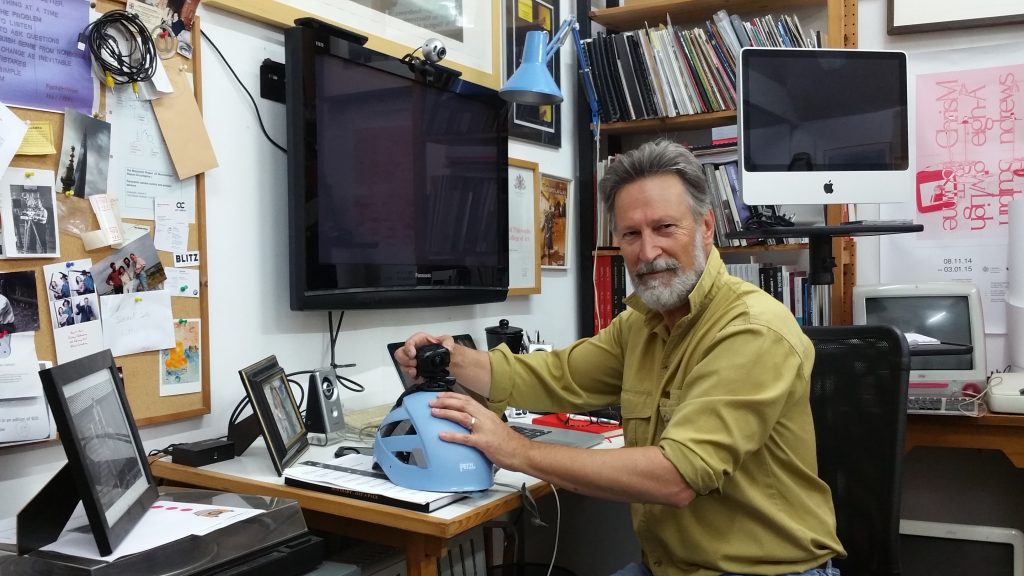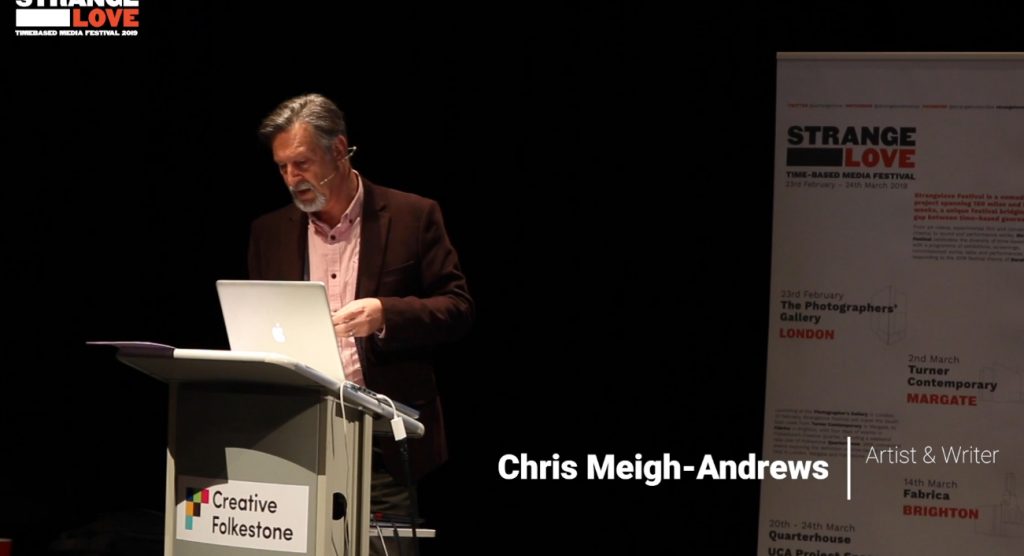Profile

Chris Meigh-Andrews in his studio. (Photo: Lupe Cunha)
Chris Meigh-Andrews first experimented with video in 1973 and began exhibiting his work internationally in the late 1970’s. His early single screen video works have featured in a number of key exhibitions: “Short Histories of Video Art, (Part 2)”, John Hansard Gallery, Southampton, 2004; “Electric Eyes: British Artists’ Video 1985-88”, Tate Gallery and the Institute of Contemporary Art (ICA), London; Museo de Arte Moderno, Medellin, Columbia, Akademie der Bildenden Kunst, Vienna 1988; “Genlock”, Interim Arts, London, (& Touring) 1988; “Video from the 70’s and 80’s”, Doggerfisher, Edinburgh, 2008; “Analogue: Pioneering British, Canadian and Polish Artists’ Video”,(1968-88), Tate Britain, Anthology Film Archives, New York, the Foundation for Art & Creative Technology (FACT), Liverpool, Museum of Contemporary Canadian Art, (MOCCA),Toronto, Arsenal Institute fur Film und Videokunst, Berlin, and the Centre for Contemporary Art, Warsaw, 2007-08 and “The Self & Surroundings”, Dundee Contemporary Arts Centre, 2012. His early video work also features in two recent DVD collections: “Rewind and Play: An Anthology of Early British Video Art”, Lux/Rewind, (2009) and “New Contemporaries Moving Image: 1968-2010”, Bloomberg/New Contemporaries, (2014).
Installation commissions include the Harris Museum, Preston (Eau d’Artifice, 1990); the Foundation for Art and Creative Technology (FACT), Liverpool, (Streamline, 1991); Camerawork, London (Cross Currents, 1993); Bath International Music Festival (Merging/Emerging, 1999); Victoria & Albert Museum, London (A Photographic Truth, 2001) and For William Henry Fox Talbot: the Pencil of Nature (2004); Huis Marseille Foundation of Photography(Temporal View in Amsterdam, 2003); the London School of Hygiene and Tropical Medicine (Returning, 2002) and Cavalier St James Centre for Creativity, Valletta (Resurrection, 2005)
Meigh-Andrews’ site-specific installations often incorporate renewable energy systems, establishing direct relationships with the natural and constructed environment. Interwoven Motion, a prototype self-powered outdoor video installation for Grizedale Forest was developed with a research award from the National Endowment of Science, Technology and the Arts (NESTA) and Arts Council England in 2004. His installation, The Monument Project (Si Monumentum Requiris, Circumspice), commissioned by architects Julian Harrap, produced a continuous stream of panoramic images from the top of the Monument in the City of London 24/7 for three years (2009-2011). Aeolian Processes (Box Revealing the Sound of its Own Making), was produced for “La Lune: Energy Producing Art”, New South Wales, Australia (2014); In Darwin’s Garden, an augmented reality installation, produced in collaboration Dr Alan Summers and in association with the National Trust was featured in the Leonardo Electronic Almanac, and Kasa Gallery, Sabinsi University, Istanbul, (2012) and Oriel Sycarth, Rexham (2017). In 2017 his two-channel outdoor installation For Issac, Alan & Steve was long-listed for the Aesthetica Art Prize.
Examples of his single screen video, installation and photographic work are held in a number of national collections including the Victoria and Albert Museum, London; Stadsarchief, Amsterdam,Muzeum Historii Fotografii, Krakow; The Harris Museum and Art Gallery, Preston; The Scottish Screen Archive at the National Library of Scotland; The British Artists’ Film & Video Collection, the BFI National Archive and the Lux Collection, as well as in a number of private collections. Documentation of his early video and installation work and a substantial collection of his photographs, papers, notes and writings have been acquired by the archive and library at Tate Britain.
Meigh-Andrews studied at the London College of Printing (Higher Dip. in Photography Film & TV), Goldsmiths (MA, Fine art ) and the Royal College of Art (PhD). He was Arts Council International Artist Fellow, Galeria Sztuki Wspólczesnej,Krakow, Poland, (2003-2004); Video Artist in Residence, Prema Arts Centre, Gloucester (1995); Video Artist in Residence, Cleveland Arts (1995); Artist in Residence, Saw Contemporary Art Centre, Ottawa, Canada (1994); Resident Artist in Digital Imaging, School of Visual Arts, Music & Publishing, Oxford Brookes University, (1994); Cambridge School of Art, Anglia Ruskin University(2017-18) and Artist-in- Residence, Gozo Contemporary, Malta, (2021), and Writer-in-Residence, at the Wallace Stegner House, Saskatchewan, Canada, (2024).
Curatorial projects include Meta Landscapes: Representations & Perceptions, Valletta Contemporary, (April-June 2022); Yes, Snow Show, (British Film Institute, 2009), Analogue: Artists’ Video from the UK, Canada and Poland: 1968-88, (Tate Britain and Modern, London, and at venues in Liverpool, Norwich, Warsaw, New York, Toronto, Ottawa, Valletta and Berlin: 2006-2009) and The Digital Aesthetic, a series of exhibitions and symposia organised in collaboration with the Harris Museum, Preston (2001, 2007 & 2012).
From 2013-2017 Meigh-Andrews was Visiting Professor at the Centre for Moving Image Research, Faculty of Arts, Creative Industries and Education at the University of the West of England (UWE). He has been external examiner for many undergraduate and post graduate courses including MA Digital Arts at the University of Malta, MA Photography-Contemporary Dialogues, Faculty of Art & Design, at the University of Wales, Trinity St David and BA and MA Digital Media at Bournemouth University, as well as for MPhil and PhD projects at Swinburne University of Technology, (Australia); University of Malta; University of Westminster; Nottingham Trent University; the Royal College of Art; Central St Martins College of Art & Design; University of Dundee, Leeds University and the University of the Punjab, (Pakistan).
Meigh-Andrews has written extensively on the history and context of artists’ video. His book, A History of Video Art: the Development of Form and Function, Berg, (Oxford and New York, 2006) and in Japanese Sangensha, (Tokyo, 2013), provides an overview of the development of artists’ video since its inception. An enlarged and expanded edition of the book was published by Bloomsbury, (London and New York, 2013) and in Mandarin by China Pictorial Publishing House,(Beijing, 2018).

Strangelove Time-Based Media Festvial, March 2019
Contributions to other books include “The Exploration of Nature, Time and the Spiritual in the Video Installation Works of Madelon Hooykaas”, The Artist as Explorer, Jap Sam Books, Amsterdam, 2023; “Sound and Vision: Early Artists’ Video and Music”, More Than Illustrated Music: Aesthetics of Hybrid Media between Pop, Art and Video, Katherine Drekmann and Elfi Vomberg, Eds, Bloomsbury, London and New York, 2023; “Digital Moving Image Installations and Renewable Energy: 1994-2018”, Technology, Design and the Arts–Challenges and Opportunities, Springer Books, Cham, Switzerland, 2020; “The Emergence of Early Artists’ Video in Europe and the USA and its Relationship to Broadcast TV”, in Materializing Memories: Dispositifs, Generations, Amateurs, Bloomsbury, (London and New York, 2018); “Location & Dislocation, Site & Architecture: Video Installation by Palestinian Artists”, in Palestinian Video Art: Constellation of the Moving Image, Bashir Makhoul, ed, Palestinian Art Court-al Hoash, (Jerusalem, 2013.) “Optiks: Peter Campus”, in The BFI Gallery Book, British Film Institute, (London, 2011) and “Video Installation in Europe and the USA: The Expansion and Exploration of Electronic and Televisual Space: 1968-1988”, inExpanded Cinema: Film Art Performance, Tate Publications, (London, 2011.);“Interwoven Motion: Steps Towards a Semi-Permanent Outdoor Self-Powered Video Installation”, in The Itemisation of Creative Knowledge, FACT/ Liverpool University Press, (Liverpool, 2006); “The Vasulka Tapes” in Vasulka Lab 1969-2005-Live Archive, Vivid, Birmingham, 2006; “Chris Meigh-Andrews: Early Video Tapes: 1978-87” in Experimental Film and Video, Jackie Hatfield, ed.,John Libbey Publishing,(Hertfordshire, 2006).
He is Editor-in-Chief, (UK and Europe) of the three-volume Encyclopedia of New Media Art for Bloomsbury Academic and is a member of the Editorial Committee for The Emergence of Video Art in Europe (1960-1980) ECAL/University of Art and Design Lausanne (HES-SO), Switzerland and University Paris-8 Vincennes – Saint-Denis, France.
Writing under the name of Charles Ambrose, Meigh-Andrews has published his first work of fiction The Grandfather Paradox,Troubador, (Market Harborough, 2025), and is currently working on a second novel, The Portal.
Contact Details:
E-mail: meighandrews@btinternet.com
Mobile/Cell: +44 (0)78 55954298